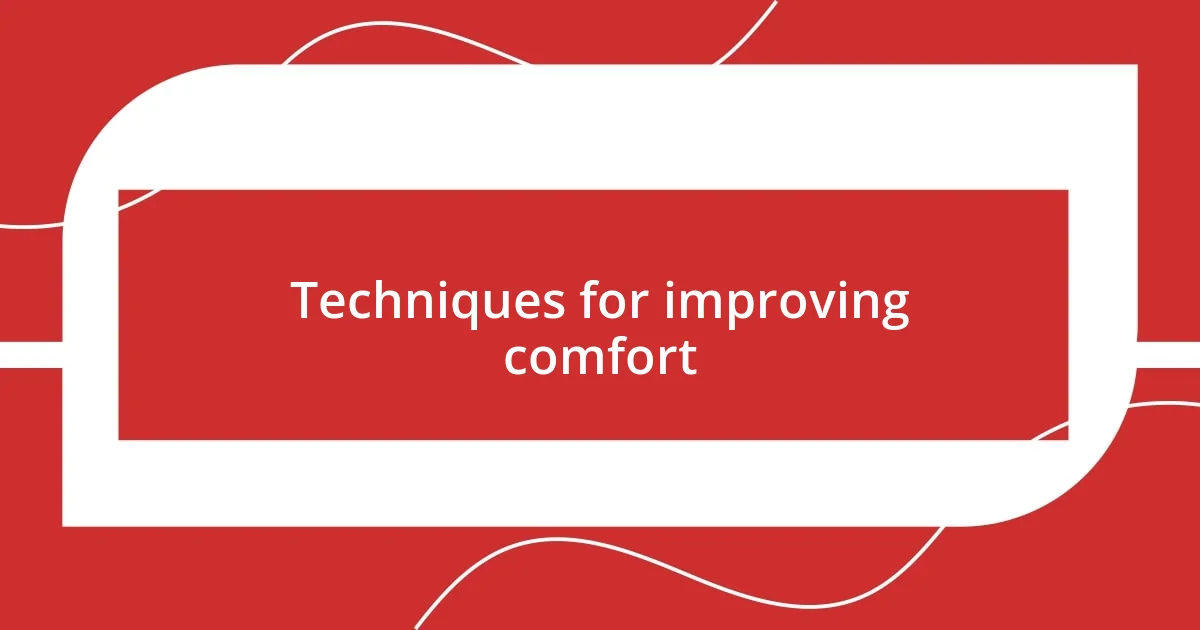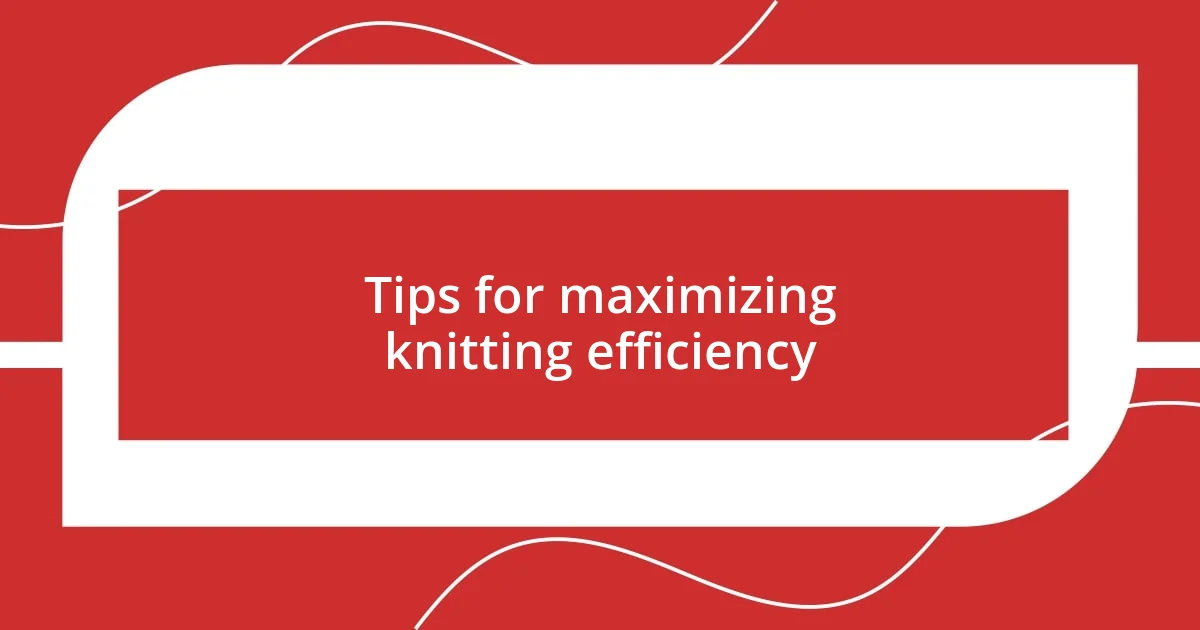Key takeaways:
- The transition to ergonomic knitting needles significantly improved comfort and reduced hand strain, rekindling the author’s passion for knitting.
- Personal techniques like posture adjustment, varied grip, and regular breaks enhanced the overall knitting experience and efficiency.
- Exploring different needle materials revealed how each type affects performance and comfort, influencing the knitting process and enjoyment.

My initial struggle with knitting
I still remember the first time I picked up knitting needles. My fingers fumbled awkwardly as I struggled to follow the pattern, and I felt a wave of frustration wash over me. Why can’t I just get this right, I thought, as my yarn tangled into a chaotic mess?
Each stitch felt like a battle, and I often wondered if I was meant to be a knitter at all. There were moments when I just wanted to toss everything aside—especially when I realized my tension was way off, resulting in uneven rows. It’s funny how a simple craft can test your patience and perseverance.
With every dropped stitch, I questioned whether I had the skills required to create something beautiful. Yet, during those challenging early days, I found myself drawn to the rhythm of the needles, as if they held the potential for something greater. It was this mix of challenge and fascination that kept me going, pushing through the initial struggles to discover what knitting could truly offer.

Discovering ergonomic knitting needles
When I first learned about ergonomic knitting needles, it felt like a lightbulb moment. I had been experiencing discomfort in my hands after long knitting sessions, and these specialized needles seemed to hold the promise of relief. Curiosity got the better of me, so I decided to give them a try.
Here’s what I found out about ergonomic knitting needles:
– Comfort: They are designed to fit naturally in your hand, which reduces strain.
– Grip: Many feature soft, textured grips that prevent slipping, making stitching so much easier.
– Angle: The angle of ergonomic needles allows for a more natural wrist position, minimizing fatigue during extended use.
– Variety: They come in various materials and sizes, accommodating every knitter’s preferences.
After a few hours of knitting with these ergonomic tools, I noticed a significant difference; my hands felt more relaxed and I could focus entirely on my project rather than the pain creeping in. It wasn’t just about the physical relief; it rekindled my passion for the craft. Who knew that a simple change could enhance my knitting experience so profoundly?

Benefits of using ergonomic needles
Using ergonomic knitting needles transformed my experience with this beloved craft. Initially, I dismissed them, thinking they were just another gimmick. But once I tried them, the comfort they provided was undeniable. I remember knitting for hours without the usual aches that would plague my hands. Suddenly, I could immerse myself in my projects, focusing on creativity rather than discomfort.
Moreover, they allowed me to knit longer without fatigue. Picture this: I was working on a complex blanket pattern that demanded hours of dedication. With standard needles, I often had to take breaks to ease the strain. After switching to ergonomic needles, I completed that blanket in record time! The joy of uninterrupted knitting gave me a sense of accomplishment that I can’t quite describe.
The difference in my knitting experience extends beyond just comfort and endurance. I noticed increased precision in my stitches too; the way these needles fit in my hand allowed for cleaner, more even rows. It felt like they were an extension of my creativity, guiding my hands effortlessly. When I think back to that turning point in my knitting journey, I can’t help but smile.
| Feature | Standard Needles | Ergonomic Needles |
|---|---|---|
| Comfort Level | Higher strain on hands | Designed to minimize strain |
| Grip | Usually smooth, may slip | Soft, textured grips |
| Wrist Position | Natural wrist angle may not be catered for | Promotes a natural wrist position |
| Knitting Duration | Shorter sessions due to fatigue | Longer sessions comfortably |

Techniques for improving comfort
One effective technique for improving comfort while knitting is adjusting your posture. I’ve noticed a huge difference when I sit up straight with my feet flat on the floor instead of slouching on the couch. In fact, it’s like flipping a switch; proper alignment not only eases tension in my neck but also helps distribute the workload across my entire body. Have you ever tried knitting in different positions? You might just be surprised at how a simple shift can transform your experience!
Using a variety of grip techniques can also enhance comfort significantly. When I switched to holding my needles more loosely, it felt as though I had unlocked a new level of knitting freedom. Gripping too tightly can lead to stiffness and cramping, which is something I learned the hard way. I encourage you to play around with your grip—finding that sweet spot can be a revelation!
Finally, taking regular breaks is essential. I sometimes set a timer to remind myself to stretch every 30 minutes; it’s a small commitment, but it makes a world of difference. Think about it: giving our hands a brief pause not only prevents fatigue but also allows my mind to reset, often leading to new creative ideas. Have you noticed how fresh inspiration can strike when you step away for a moment? It’s like coming back to your work with a whole new perspective!

Comparing different needle materials
When it comes to knitting needles, the material they’re made from can greatly affect both performance and comfort. I’ve tried a range of materials, from aluminum to bamboo, and each has a distinct feel. For instance, aluminum needles glide effortlessly through stitches, but I found they can sometimes feel cold in my hands, especially during colder months. Anyone else ever felt that difference when starting a project?
Bamboo needles, on the other hand, are warm to the touch and provide a lovely grip. I remember using them on a chilly evening, and it was comforting to knit without that stiff feel. They also have a slight friction that can help prevent stitches from slipping off, perfect for intricate patterns. But I’ve also noticed they can be a bit slower for faster knitting styles. How about you? Do you prioritize speed or comfort in your projects?
Then we’ve got the slickness of plastic needles. At first glance, I was skeptical. They seemed too light and flimsy, but I was pleasantly surprised by their durability and smoothness. I remember knitting a large project with them and appreciating how they allowed my fingers to move swiftly. However, the downside is that they can sometimes feel a bit less tactile and disconnected from the yarn. Which material resonates with your knitting style?

Tips for maximizing knitting efficiency
While it may seem simple, organizing your workspace can dramatically improve your knitting efficiency. I remember the first time I cleared away clutter from my knitting area; it was like opening a window to creativity! Now, I keep my tools and yarn within arm’s reach, which allows me to stay in my flow rather than constantly searching for supplies. Have you ever noticed how a tidy space makes it easier to focus?
In addition, being mindful of your yarn tension can lead to a smoother knitting experience. I used to ignore how tightly I pulled my yarn, resulting in uneven stitches that slowed me down. It was a revelation when I finally paid attention; adjusting my tension led to more uniform stitches and faster progress. Have you tried experimenting with different tension levels? You might find, like I did, that it can really make a difference!
Lastly, setting goals for each knitting session has proven invaluable. I usually plan to complete a certain number of rows or a specific section of a project, which gives me a sense of accomplishment. I’ve noticed that when I have clear objectives, I feel more productive and less overwhelmed. Isn’t it interesting how a little bit of structure can enhance creativity in such an enjoyable activity?

Sharing my personal success story
I can vividly recall my journey into ergonomic knitting needles. Initially, I wasn’t convinced they would make any significant difference, but after just a few weeks of regular use, my knitting sessions transformed. The relief in my hands and the reduction in tension were undeniable. Have you ever felt a small change lead to a remarkable improvement in your craft?
One particular moment stands out: I was halfway through a large blanket project when my usual arthritis flared up. I decided to try out my new ergonomic needles, and to my surprise, the discomfort lessened almost immediately. It was like I had discovered a hidden gem in my knitting toolbox. The difference in grip and control allowed me to keep going, even when I thought I’d have to stop. Can you imagine being able to continue a beloved craft despite physical discomfort?
Reflecting on my experience, I realize how much joy ergonomic needles have brought back to my knitting practice. Every stitch feels more fluid, and I find myself enjoying the process rather than just focusing on the finished product. It’s interesting how a simple shift in tools can reignite passion, isn’t it?















